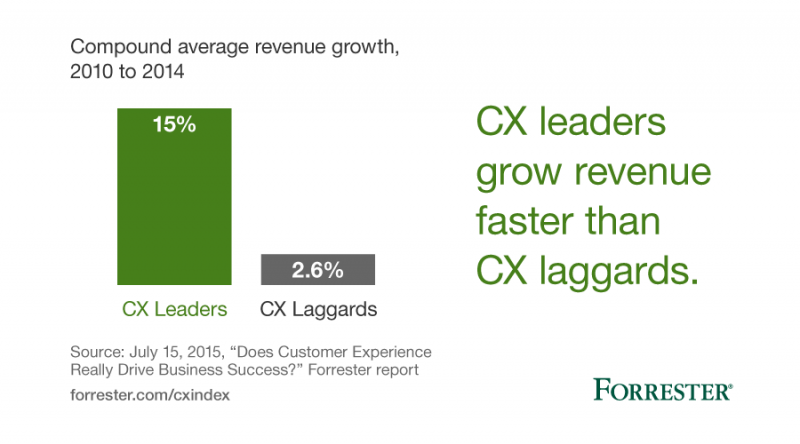Don’t Let Volatile Markets Scare You Away From Customer Experience Investments
If you like horror shows, forget The Walking Dead and check out global markets: In 2016, US stocks got off to their worst start ever. Oil prices are in the toilet — taking oil company stocks with them — and neither looks to fully recover any time soon. Of course, both of these Nightmares on Wall Street might pale in comparison to what a Brexit could do to volatility in foreign exchange rates (and therefore your profit and loss).
In the past, you might have expected China to ride to the rescue. But that won’t happen: The Chinese economy just grew at its slowest rate in 25 years.
Companies that obsess over these developments might be tempted to panic and cut spending on customer experience improvement programs, despite the fact that many firms are sitting on piles of cash. But cutting CX budgets is a terrible idea because CX is the greatest potential source of competitive advantage — especially in times of high market volatility. For example:
- CX leaders grow revenue 3x faster than CX laggards. Forrester recently analyzed the correlation between customer experience and revenue growth for seven industries in the US between 2010 and 2014. We found that companies with superior customer experience grew revenues faster than their competitors with inferior customer experience: On average, the eight CX leaders had revenue CAGR of 15%, while their eight CX laggard competitors grew at an average rate of 2.5%.
- Superior CX drives customer loyalty and purchase intent. When customers have a good experience, it makes them want to stay with you longer, spend more with you, and recommend you. There’s money in this insight: We proved the link between customer experience, loyalty, and purchase intent. This relationship holds true for mass-market brands like wireless service providers as well as high-end brands like luxury autos. In fact, it even holds true for industries where we’d expect customers to be left-brained and numbers-oriented, like banks, credit card issuers, insurers, and investment firms.
- Companies with superior CX can charge more for their products. Customers are willing to pay a higher price in return for a superior customer experience. That’s what we found when we analyzed US data from Forrester’s Customer Experience Index (CX Index) to determine the relationship between the CX Index score that customers give a brand and their willingness to pay a premium for that brand. And it’s especially true for customers who rate an experience as outstanding (i.e., delighting customers gets you margin).
 And that’s just the upside. The downside risk of not funding CX improvements is also high: Competitors who improve their customer experience while you stagnate will steal your customers and erode your margins. You’ll make it even easier for them if your employees become disengaged as a result of your CX flip-flop and start delivering a less satisfying experience.
And that’s just the upside. The downside risk of not funding CX improvements is also high: Competitors who improve their customer experience while you stagnate will steal your customers and erode your margins. You’ll make it even easier for them if your employees become disengaged as a result of your CX flip-flop and start delivering a less satisfying experience.
We realize that despite these harsh realities, it’s tough to stay focused when the world around you seems on the verge of panic. So here’s some advice to help keep you and your colleagues grounded:
- Connect with your customer pulse. Customers tend to have fast, knee-jerk responses to volatility. But over time, the loyalty they show in response to superior customer experience stays evident — if you bother to look. Establish habits like regularly listening into contact center calls and reading customer ratings and reviews of your products and services (and those of your competitors). You’ll hear a constant drumbeat of feedback about the experiences you provide — not so much about the Dow or the 10-year T-note.
- Do the math. Knowing that improving customer experience increases customer loyalty, add up the financial benefit of a 1 percentage point increase in customer retention for your company. Now try subtracting the financial loss from a 1 percentage point drop if your CX stagnates and your competitors start luring away your customers. Whether you run the numbers based on revenue or profit, this exercise will help you make a visceral connection with what’s at stake.
- Look up at the CX leaders. Top CX performers stand out when it comes to business performance, too. As of this writing, top-ranked PC manufacturer Apple has the highest market cap of any company on the planet. Amazon’s trailing 12-month revenue of $107 billion beats Microsoft and Facebook combined. And in an industry where success means avoiding bankruptcy, 2015 marked the 42nd consecutive year of profitability for Southwest. Seeing the real-world correlation between CX success and business success will help you overcome lingering doubts as to whether this connection is real.
As 2016 progresses, you can’t count on the markets settling down. But you can count on us for upcoming research that connects customer experience to revenue, profitability, customer loyalty, cost reduction, and pricing power. Watch this space for more top-line findings.
